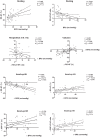Trigonometric regressive spectral analysis reliably maps dynamic changes in baroreflex sensitivity and autonomic tone: the effect of gender and age
- PMID: 20808439
- PMCID: PMC2922332
- DOI: 10.1371/journal.pone.0012187
Trigonometric regressive spectral analysis reliably maps dynamic changes in baroreflex sensitivity and autonomic tone: the effect of gender and age
Abstract
Background: The assessment of baroreflex sensitivity (BRS) has emerged as prognostic tool in cardiology. Although available computer-assisted methods, measuring spontaneous fluctuations of heart rate and blood pressure in the time and frequency domain are easily applicable, they do not allow for quantification of BRS during cardiovascular adaption processes. This, however, seems an essential criterion for clinical application. We evaluated a novel algorithm based on trigonometric regression regarding its ability to map dynamic changes in BRS and autonomic tone during cardiovascular provocation in relation to gender and age.
Methodology/principal findings: We continuously recorded systemic arterial pressure, electrocardiogram and respiration in 23 young subjects (25+/-2 years) and 22 middle-aged subjects (56+/-4 years) during cardiovascular autonomic testing (metronomic breathing, Valsalva manoeuvre, head-up tilt). Baroreflex- and spectral analysis was performed using the algorithm of trigonometric regressive spectral analysis. There was an age-related decline in spontaneous BRS and high frequency oscillations of RR intervals. Changes in autonomic tone evoked by cardiovascular provocation were observed as shifts in the ratio of low to high frequency oscillations of RR intervals and blood pressure. Respiration at 0.1 Hz elicited an increase in BRS while head-up tilt and Valsalva manoeuvre resulted in a downregulation of BRS. The extent of autonomic adaption was in general more pronounced in young individuals and declined stronger with age in women than in men.
Conclusions/significance: The trigonometric regressive spectral analysis reliably maps age- and gender-related differences in baroreflex- and autonomic function and is able to describe adaption processes of baroreceptor circuit during cardiovascular stimulation. Hence, this novel algorithm may be a useful screening tool to detect abnormalities in cardiovascular adaption processes even when resting values appear to be normal.
Conflict of interest statement
Figures




Similar articles
-
Trigonometric regressive spectral analysis: an innovative tool for evaluating the autonomic nervous system.J Neural Transm (Vienna). 2013 Sep;120 Suppl 1:S27-33. doi: 10.1007/s00702-013-1054-5. Epub 2013 Jun 28. J Neural Transm (Vienna). 2013. PMID: 23812502 Review.
-
Measures of cardiovascular autonomic regulation derived from spontaneous methods and the Valsalva maneuver.Auton Neurosci. 2003 Jan 31;103(1-2):100-5. doi: 10.1016/s1566-0702(02)00151-0. Auton Neurosci. 2003. PMID: 12531403
-
Baroreflex sensitivity and power spectral analysis during autonomic testing in different extrapyramidal syndromes.Mov Disord. 2010 Feb 15;25(3):315-24. doi: 10.1002/mds.22844. Mov Disord. 2010. PMID: 20014116
-
Determination of baroreflex sensitivity during the modified Oxford maneuver by trigonometric regressive spectral analysis.PLoS One. 2011 Mar 18;6(3):e18061. doi: 10.1371/journal.pone.0018061. PLoS One. 2011. PMID: 21437258 Free PMC article. Clinical Trial.
-
Baroreflex sensitivity: measurement and clinical implications.Ann Noninvasive Electrocardiol. 2008 Apr;13(2):191-207. doi: 10.1111/j.1542-474X.2008.00219.x. Ann Noninvasive Electrocardiol. 2008. PMID: 18426445 Free PMC article. Review.
Cited by
-
Autonomic Nervous System Control in Male and Female Elite Soccer Players: Importance of Different Training Routines and Perceived Stress.J Cardiovasc Dev Dis. 2025 Apr 10;12(4):150. doi: 10.3390/jcdd12040150. J Cardiovasc Dev Dis. 2025. PMID: 40278209 Free PMC article.
-
Cardiac Autonomic Nervous System Activity during Slow Breathing in Supine Position.Rehabil Res Pract. 2021 Feb 27;2021:6619571. doi: 10.1155/2021/6619571. eCollection 2021. Rehabil Res Pract. 2021. PMID: 33728068 Free PMC article.
-
Trigonometric regressive spectral analysis: an innovative tool for evaluating the autonomic nervous system.J Neural Transm (Vienna). 2013 Sep;120 Suppl 1:S27-33. doi: 10.1007/s00702-013-1054-5. Epub 2013 Jun 28. J Neural Transm (Vienna). 2013. PMID: 23812502 Review.
-
Spectral Analysis of Heart Rate Variability: Time Window Matters.Front Neurol. 2019 May 29;10:545. doi: 10.3389/fneur.2019.00545. eCollection 2019. Front Neurol. 2019. PMID: 31191437 Free PMC article.
-
Severity of traumatic brain injury correlates with long-term cardiovascular autonomic dysfunction.J Neurol. 2017 Sep;264(9):1956-1967. doi: 10.1007/s00415-017-8581-1. Epub 2017 Aug 2. J Neurol. 2017. PMID: 28770375 Free PMC article.
References
-
- Hilz MJ, Stemper B, Neundorfer B. [Physiology and methods for studying the baroreceptor reflex]. Fortschr Neurol Psychiatr. 2000;68:37–47. - PubMed
-
- Korner PI. Baroreceptor resetting and other determinants of baroreflex properties in hypertension. Clin Exp Pharmacol Physiol. 1989;Suppl 15:45–64. - PubMed
-
- Goldstein DS. Arterial baroreflex sensitivity, plasma catecholamines, and pressor responsiveness in essential hypertension. Circulation. 1983;68:234–240. - PubMed
-
- Brown CM, Hecht MJ, Weih A, Neundorfer B, Hilz MJ. Effects of age on the cardiac and vascular limbs of the arterial baroreflex. Eur J Clin Invest. 2003;33:10–16. - PubMed
Publication types
MeSH terms
LinkOut - more resources
Full Text Sources

